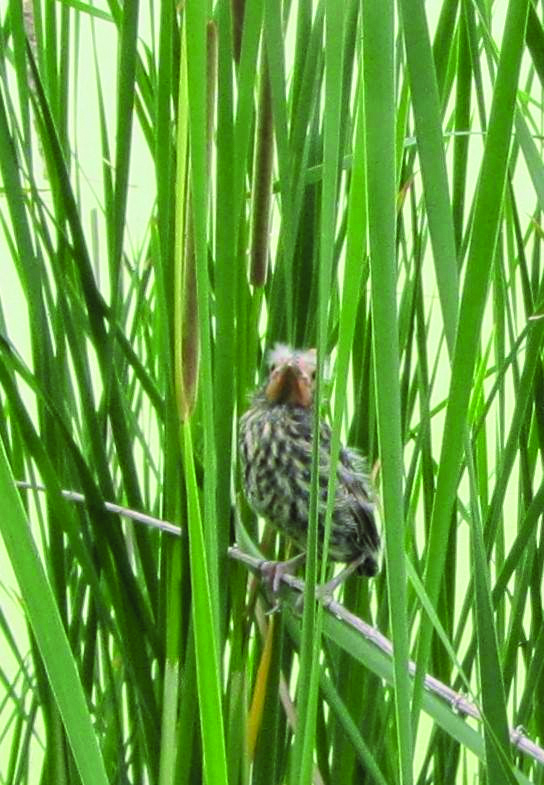

By Kathlean Wolf
Wild Warner
Ice melts from the surface of the pond, brightening bark shines willow-gold and dogwood-red, and a trilling song from the tops of cattail stems announces “On-ka-leeeee! On-ka-leeeee!” The red-winged blackbirds have returned.
Red winged blackbirds are the most common perching bird in the United States, but they’re no less interesting just because they’re common. They have a surprising variety of songs, calls and gestures; and observing their activities can teach us a lot about life in the marsh.
Males are the first to arrive in Wisconsin from the south, and they take these few extra weeks to establish their territory, competing with other males by displaying the red shoulder band that gives these birds their name. The bands grow larger as birds grow older, and the largest red bands appear to intimidate younger males with a smaller amount of red. Females, arriving a few weeks later, care less about this striking epaulet, focusing mainly on a healthy male with a good singing voice and a claim to high-quality nesting grounds.
Up to five females may choose to share one male as their primary mate, though they breed with other males and the chicks in one clutch may have more than one father. Their habit of clustering together, as well as building nests a foot or two above water, gives them a fighting chance against the many predators that take an interest in blackbird eggs and fledglings: raccoons, minks, owls, hawks, snakes and marsh wrens.
Weaving a bowl-shaped nest in the reeds or cattails, females lay three or four pale blue eggs, which hatch in about 12 days. Two weeks later, the babies fledge and begin to leave the nest, still under the watchful eye of parents as they become comfortable fliers. Soon after, the females will begin raising another clutch, and may even have a third before summer’s end.

My experiences with red winged blackbirds have usually been as an intruder into their territory as I forage for cattail pollen or pull human trash from among the cattails and bullrushes. It’s obvious when I’ve come into their territory, as they begin warning me off with the less lovely of their calls, a harsh creak-rattle, taken up by other red wings up and down the shore. If I rudely pass through their territorial perimeter, I hear a strong warning cry, a sharp, piercing “Tseet!” as one or both parents begin flying overhead.
I usually take heed, turn and circle around to a less-occupied stretch of the shore. On the rare occasion I’ve come a few steps closer, the parents back away and go quiet, murmuring anxiously but trying not to give away their babies’ position. I once found myself staring down an unfledged baby, looking indignant at the intrusion as I took a few photos.
Red wing blackbirds are rarely seen on birdfeeders, but for the past two years, they’ve visited mine. I first noticed a father bringing his three squabbling fledglings, arguing competitively over my offering of sunflower seeds. They were fluffy enough to make them look larger than their parent. A short while later, while out on a walk, I heard the same father screaming at a large hawk, which winged its way over the woods with a bird in its talons. After that, there were only two squabbling babies at the feeder, attended by their father.
This year, my first notice of the return of the red winged blackbirds was at my own feeder — a young male with no red on his shoulder at all. I think he must be one of last year’s babies, once so argumentative and demanding. Now, though he’s at least a year away from being able to claim his own territory, his fine singing voice has been my own personal herald of spring.